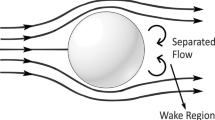Abstract
The method to enhance the performance of race cars by adding downforce producing devices is well established and started in the 1960s when wings were first used. In short, wings enhance the effectiveness of the tires by increasing the load on the tires without adding the equivalent mass. As mentioned earlier, wings increase race car performance by providing a “massless” load to the tires. The wings will add weight to the vehicle, and the performance gain must outweigh the drawbacks of this extra weight and the addition of drag that the wing also cause. As a key characteristic of the vehicle, aerodynamic characteristics have close relationships with handling stability, safety, dynamics, fuel economy, and so on. The aerodynamic characteristics’ influence on the vehicle performance is particularly obvious; for formula cars with exposed wheels, the car wheel resistance accounted for the proportion of the total resistance sometimes can go to over 45%. In the car development process, researchers pay great attention to the car aerodynamic characteristics research and optimization, and aerodynamics package has become an important part of the car. Optimization is one of the most important parts of the aerodynamic devices design because optimization is done by taking into consideration of many parameters. First, the wings are optimized to the maximum downforce and minimum drag individually by altering the angle of attack of both the ME (main element) and FE (flap element) and the position of the flap element concerning the main element. Then the individually optimized wings are incorporated into the CAD (Computer Aided Design) model and further optimized to tune the wings to get the maximum efficiency out of the car.
Access this chapter
Tax calculation will be finalised at checkout
Purchases are for personal use only
Similar content being viewed by others
References
Rehnberg S, Börjesson L, Svensson R, Rice J (2013) Race car aero-dynamics—the design process of an aerodynamic package for the 2012 chalmers formula SAE car. In: SAE technical papers, vol 2. https://doi.org/10.4271/2013-01-0797
Mariani F, Poggiani C, Risi F, Scappaticci L (2015) Formula-SAE racing car: experimental and numerical analysis of the external aero-dynamics. Energy Procedia 81:1013–1029. https://doi.org/10.1016/j.egypro.2015.12.111
Shao S, Zhang Y, Zhao J, Tang W (2013) The influence of wheel rotating to FSAE racing car aerodynamic characteristics. Appl Mech Mater 300–301:1054–1057. https://doi.org/10.4028/www.scientific.net/AMM.300-301.1054
Jagadeep J, Tech RB, Finding the optimum angle of attack for the front wing of an F1 car using CFD
Oxyzoglou I, Pelekasis N (2017) Design and development of an aerodynamic package for a FSAE race car
Ao S-I, Gelman L, Hukins DWL, International association of engineers, World congress on engineering: WCE 2016: 29 June–1 July, 2016, Imperial College London, London, U.K.
Doddegowda P, Bychkovsky AL, George AR (2006) SP-1991
Deng Z, Yu S, Wu C (2020) Numerical simulation and analysis for aerodynamic devices of FSAE racing car. J Phys: Con Ser 1600(1). https://doi.org/10.1088/1742-6596/1600/1/012079
Chen M, Tang W, Yang B, Hu X (2012) Computer-aided front and rear wings aerodynamic design of a formula SAE racing car. Appl Mech Mater 120:20–25. https://doi.org/10.4028/www.scientific.net/AMM.120.20
View of numerical investigation on the pressure drag of some low-speed airfoils for UAV application
Author information
Authors and Affiliations
Corresponding author
Editor information
Editors and Affiliations
Rights and permissions
Copyright information
© 2023 The Author(s), under exclusive license to Springer Nature Singapore Pte Ltd.
About this paper
Cite this paper
Bavapuram, V.S.S., Suresh, S.N., Sharma, S., Kaushik, V. (2023). Aerodynamic Performance Analysis of Formula-Based Vehicle Through Ansys. In: Sharma, R., Kannojiya, R., Garg, N., Gautam, S.S. (eds) Advances in Engineering Design. FLAME 2022. Lecture Notes in Mechanical Engineering. Springer, Singapore. https://doi.org/10.1007/978-981-99-3033-3_12
Download citation
DOI: https://doi.org/10.1007/978-981-99-3033-3_12
Published:
Publisher Name: Springer, Singapore
Print ISBN: 978-981-99-3032-6
Online ISBN: 978-981-99-3033-3
eBook Packages: EngineeringEngineering (R0)




